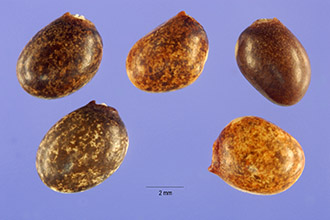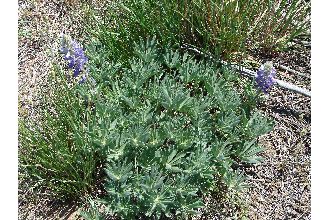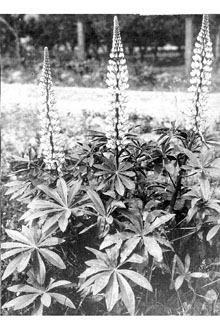Bigleaf Lupine
Scientific Name: Lupinus polyphyllus Lindl.

| General Information | |
|---|---|
| Usda Symbol | LUPO2 |
| Group | Dicot |
| Life Cycle | Perennial |
| Growth Habits | Forb/herb |
| Native Locations | LUPO2 |
Plant Guide
Alternate Names
Alternate Common Names: large leaf lupine, large-leaved lupine, Washington lupine, garden lupine, marsh lupine, blue-pod lupine, altramuz perenne Alternate Scientific Names: Due to its large geographic range, adaptability, and tendency to hybridize, there are several different forms of this species that have been variously treated by botanists as subspecies, varieties, or taxonomic synonyms, including the following: Lupinus arcticus S. Wats. var. prunophilus (M.E. Jones) C.P. Sm., Lupinus burkei S. Wats. ssp. burkei, Lupinus garfieldensis C.P. Sm., Lupinus matanuskensis C.P. Sm., Lupinus polyphyllus Lindl. ssp. bernardinus (Abrams ex C. P. Sm.) Munz, Lupinus polyphyllus Lindl. ssp. polyphyllus, Lupinus polyphyllus Lindl. ssp. superbus (A. Heller) Munz, Lupinus polyphyllus Lindl. var. albiflorus Lindl., Lupinus polyphyllus Lindl. var. burkei (S. Watson) C. L. Hitchc., Lupinus polyphyllus Lindl. var. humicola (A. Nelson) Barneby, Lupinus polyphyllus Lindl. var. grandifolius (Lindl. ex J. Agardh) Torr. & A. Gray, Lupinus polyphyllus Lindl. var. pallidipes (A. Heller) C. P. Sm., Lupinus polyphyllus Lindl. var. polyphyllus, Lupinus polyphyllus Lindl. var. prunophilus (M.E. Jones) L. Phillips, Lupinus polyphyllus Lindl. var. saxosus (Howell) Barneby, Lupinus prunophilus M.E. Jones, Lupinus pseudopolyphyllus C.P. Sm., Lupinus stationis C.P. Sm., Lupinus wyethii S. Wats. var. prunophilus (M.E. Jones) C.P. Sm.
Uses
Pollinator habitat: Bigleaf lupine attracts native bees, bumble bees, and other beneficial insects with its nectar and pollen-rich flowers that bloom from mid-spring into mid-summer (Ley et al., 2007). It also attracts hummingbirds, contributing to the biodiversity of any site. Ornamental: Also commonly known as garden lupine, its pleasant fragrance and tall, showy flowers make the plant a favorite ornamental for gardeners across the country. Take care to manage the lupines properly as some ornamental hybrids can become weedy and problematic. Restoration: Plants may be used for prairie or wetland restoration as an important component of the native flora. They are deep rooted and suitable for erosion control and soil stabilization. Also, as a native legume, they can be used in revegetation of logging roads or clear cuts as nitrogen fixers (Pojar and MacKinnon, 1994).
Ethnobotany
Tribes throughout the range of bigleaf lupine reportedly used different parts of the plant for medicinal or tonic purposes (Moerman, 2003). Although the Thompson tribes of British Columbia considered it poisonous, they used it medicinally for themselves and their horses. The Salishan used it to make tonics and the Kwakiutl ate the roots, fresh or steamed. The Kashaya Pomo used its flowers ceremoniously in dances and festivals.
Status
Throughout its native range in the western U.S., bigleaf lupine has a facultative (FAC) indicator status, meaning it is just as likely to occur in wetlands as uplands (USFWS, 2012). Where it has become invasive in the Midwest, North Central and Northeastern regions, it is considered a facultative upland species (FACU), meaning it occasionally occurs in wetlands but is usually found in uplands. In the Great Plains, however, it has a facultative wetland (FACW) status, meaning it is usually found in wetlands, but occasionally occurs in uplands. Please consult the PLANTS Web site and your State Department of Natural Resources for this plant’s current status (e.g., threatened or endangered species, state noxious status, and wetland indicator values).
Weediness
Lupinus polyphyllus ssp. polyphyllus has been reported as problematic in the eastern portion of North America (Martin and Hawley, 2012). This “garden lupine” or “Russell hybrid” is an escaped hybrid ornamental and may become weedy or invasive in some regions or habitats, displacing desirable vegetation if not properly managed. Please consult with your local NRCS Field Office, Cooperative Extension Service office, state natural resource, or state agriculture department regarding its status and use. Weed information is also available from the PLANTS Web site at http://plants.usda.gov/. Please consult the Related Web Sites on the Plant Profile for this species for further information.
Description
General: This native perennial forb is a legume with a highly variable growth habit. Some varieties grow a large crown and can reach 5 feet tall, while others are highly rhizomatous, branching out many feet, but growing only 6 inches to a few feet tall. Its hollow stalks and large palmate leaves may be hairy to smooth, and at maturity produce 3-inch to 1.5-ft tall racemes of showy white-pink to purplish-blue flowers (Sholars, 2012). Flowering typically occurs from May through July or August, with the hairy pods ripening somewhat unevenly, turning a light grayish tan to dark brown. Pods will produce 3 to 9 small (approximately ¼ inch in length), bean-shaped, mottled brown seeds. Plants are long-lived, usually lasting three years, and possibly much longer. Distribution: Bigleaf lupine is native to western North America, from British Columbia and Alberta south to California and east to Montana, Idaho and Nevada. In the East, subspecies polyphyllus is considered invasive and has spread across the Great Lakes states, into the northeastern coastal states, and eastern Canada. The species is also found in Alaska, but is believed to have also been introduced there. For current distribution, please consult the Plant Profile page for this species on the PLANTS Web site. Habitat: This species prefers moist habitats and seasonally wet soils, but will tolerate seasonal dryness (Robson et al., 2008). It is commonly found in a variety of habitat types including seasonally dry to marshy meadows, wetlands and damp forests, along stream banks and ditches, and in disturbed areas (Turner and Gustafson, 2006).
Adaptation
Although bigleaf lupine prefers cool, subalpine climates and damp to wet soils, it can also tolerate full sun and seasonally drier soils (Robson et al., 2008). Observations indicate it can even prefer acidic, nutrient-poor mineral soils, giving it a competitive advantage over other plants in the community (Fremstad, 2010). This is a very Photo courtesy of G. D. Carr, Oregon Flora Project, 2006 versatile plant that will grow almost anywhere with few management needs.
Establishment
Prior to planting, reduction of the weed seed bank on site and proper field preparation is important. Bigleaf lupine, like many legumes, has hard-coated seeds, so will germinate unevenly if not scarified prior to sowing. Scarified seeds or plugs should be started in moist to wet soils. Fortunately because of its rapid spring growth, this species can be quite competitive with weeds if established from transplants in early spring. Scarified seeds can also be sown in fall or spring, but competition with weeds may limit establishment success. For broadcast seeding, the recommended single-species rate ranges from 10 to 35 lb/acre, depending on use and site conditions. There are approximately 19-30,000 seeds per pound, so sowing at a rate of 10 pure live seed (PLS) pounds per acre will result in 4 to 7 seeds per square foot. Establishment and subsequent growth may also be improved by inoculating with nitrogen-fixing bacteria (Rhizobium lupini) prior to planting to aid the formation of root nodules. Plants are hearty and will grow throughout the first year, reaching maturity and flowering the second year.
Management
Pests and Potential Problems
Aphids and powdery mildew are known to be problematic for this species. High rates of infestation can weaken plants, and can lower seed yields if in production.
Environmental Concerns
Concerns
Concerns
Seeds may be toxic to ruminant livestock or wildlife if consumed in large quantities (Forero et al,, 2011), Many lupines hybridize with other species of lupines, Use soil moisture sensors to measure the soil moisture of Bigleaf Lupine., If the plants are in seed production or it is necessary to keep species purity, be sure to isolate different species and populations by at least 1000 ft,
Control
Introduced L. polyphyllus hybrids are highly adaptable and can become weedy and cause problems for areas outside of their native range. An application of glyphosate, where applicable or indicated, has been effective in diminishing localized populations; alternatively, a frequent mowing or deadheading before flowering or before seed pods ripen will help prevent further spread (Fremstad, 2010). Please contact your local agricultural extension specialist or county weed specialist to learn what works best in your area and how to use it safely. Always read label and safety instructions for each control method.
Seeds and Plant Production
Plant Production
Plant Production
Planting: Bigleaf lupine can be hard-seeded, so physical or chemical scarification can improve uniformity of germination. The preferred planting method for seed production fields of this species is to plant plugs on wide row spacing (24–36 inches) to accommodate plant size and weed management strategies. Direct seeding is not recommended because weeds can out-compete seedlings in the spring. However, if direct sowing is desired, sow in the spring in 16- to 30-inch wide rows, at 10–12 lb per acre, and at a depth of ½ to ¾ inch. Wider spacing allows for initial tillage or herbicide application between rows. An application of a balanced fertilizer (15-15-15) following planting may aid establishment. There are no herbicides labeled for use on lupines when grown for seed. Hand hoeing, herbicide spot treatments, and row tillage are some weed management options. Harvest: These plants usually do not flower their first growing season. After blooming the second year, the pods are ripe when they turn a light tan to dark brown color and feel very dry. Stalks of pods can be hand harvested as they mature, or directly combined if maturity across the field is uniform. Combined materials should be laid out in a warm, dry place to cure before cleaning. Seeds can be expelled many feet from the pods, so cover material with a netted fabric (such as shadecloth or remay) as it is drying. Combining during harvest takes much of the bulk plant material off the field, but plants may benefit from an additional mowing (no lower than 4”) before winter. Plants are mostly dormant in late summer and throughout the winter. New leaves begin to emerge from the crown in early spring. Seed cleaning: A combine or stationary thresher will break open the seed pods, and seeds can then be separated from plant materials or other organic matter using an air-screen machine. Seeds are large, easily identifiable, and readily separated from other materials. In Corvallis, OR, annual yields average 200 to 300 pounds per acre , depending on harvest methods employed. A typical stand can be productive for upwards of three years. Photo by Robert C. Hoffman, NRCS Corvallis Plant Materials Center, 2012. Cultivars, Improved, and Selected Materials (and area of origin) There are a number of horticultural cultivars available commercially that are sometimes called bigleaf lupines but are actually crosses of L. polyphyllus with L. arboreus and possibly L. nootkatensis. These Russell Hybrids (named for British horticulturist George Russell) are sold under hybrid names such as Rainbow Lupins, Lupin Tutti Fruitti, and Band of Nobles (mixed), Chandelier (yellow), My Castle (red), Noble Maiden (white), The Chatelaine (pink), and The Governor (blue). Container plants or seed of native varieties are generally available from commercial native plant growers in the West.
References
Forero, L., G. Nader, A. Craigmill, J.M. Ditomaso, B. Puschner, and J. Maas. 2011. Livestock-poisoning plants of California. Publication 8398. Agriculture and Natural Resources, Univ. of California. http://anrcatalog.ucdavis.edu/pdf/8398.pdf (accessed 12 Dec 2012). Fremstad, E. 2010. Invasive alien species fact sheet – Lupinus polyphyllus. – From: Online Database of the European Network on Invasive Alien Species – NOBANIS www.nobanis.org (accessed 12 Dec 2012). Ley, E.L., S. Buchmann, K. McGuire, and R. Holmes. 2007. Selecting plants for pollinators: a regional guide for farmers, land managers, and gardeners in the Pacific Lowland Mixed Forest Province. Pollinator Partnership and the North American Pollinator Protection Campaign, San Francisco. http://pollinator.org/PDFs/Guides/PacificLowlandrx9FINAL.pdf (accessed 24 Aug. 2012). Martin, R., and R. Hawley. 2012. Lupinus polyphyllus invasive to Maine. Gulf of Maine Research Institute. http://vitalsignsme.org/sites/default/files/content/ui_lupinus_polyphyllus_090412.pdf (accessed 24 Aug. 2012). Moerman, D., editor. 2003. Native American ethnobotany database. Univ. of Michigan, Dearborn. http://herb.umd.umich.edu/ (accessed 24 Aug. 2012). Pojar, J., and A. MacKinnon, editors. 1994. Plants of the Pacific Northwest Coast: Washington, Oregon, British Columbia & Alaska. Lone Pine Publishing, Vancouver. Robson, K.A., A. Richter, and M. Filbert. 2008. Encyclopedia of Northwest native plants for gardens and landscapes. Timber Press, Inc., Portland. Sholars, T. 2012. Lupinus. In: J.C. Hickman, ed., The Jepson manual of higher plants of California, Univ. of California. http://ucjeps.berkeley.edu/cgi-bin/get_IJM.pl?tid=32018 (accessed 12 Dec 2012). Turner, M., and P. Gustafson. 2006. Wildflowers of the Pacific Northwest. Timber Press, Portland. USFWS (United States Fish and Wildlife Service). 2012. 2012 National wetland plant list. In: The PLANTS database, USDA-NRCS, National Plant Data Center. http://plants.usda.gov/wetland.html (accessed 09 Sept. 2012). Photo Credit: Carr, G.D. Lupinus polyphyllus. Oregon Flora Project. www.oregonflora.org (accessed 30 Aug. 2012). Prepared By: Mary Beuthin, USDA NRCS Corvallis Plant Materials Center, Oregon Citation Beuthin, M. 2012. Plant guide for bigleaf lupine (Lupinus polyphyllus). USDA-Natural Resources


